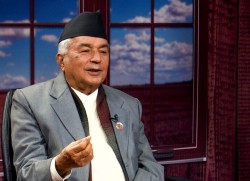Nepal

Did you know?
The 5.3 magnitude jolt that gave you a rude shake early Saturday morning was an aftershock of the devastating Gorkha earthquake.
Saturday morning's tremor was the latest of over 580 aftershocks of Gorkha Earthquake measuring 4 magnitude or more that have occurred in Nepal since April 2015, said Bharat Prasad Koirala, senior seismologist at National Earthquake Measurement and Research Centre (NEMRC).
Two aftershocks of the Gorkha Earthquake occurred in a short span of 12 days, according to Koirala.
“Although it occurred within a week of the 6 ML Khotang quake, it is not an aftershock of that one," Koirala said. "It is an aftershock of the Gorkha Earthquake."
Monday morning's quake is the third to shake western and central Nepal within 12 days, measuring over 4 magnitude.
Aftershocks galore
Many smaller aftershocks of the Gorkha Earthquake occurred throughout Saturday, according to NEMRC. "They were all below 4 magnitude and we didn't even post them on our website," said Koirala. "But every tremor is recorded in our database."
What is an aftershock?
Aftershocks are the lower-magnitude tremors that follow the principal earthquake. When a major earthquake hits, some of the energy is transferred to the rocks nearby. The energy thus transferred adds to the accumulation of energy of the nearby rocks and gets released over time producing aftershocks.
Before the Gorkha Earthquake, there were a certain amount of quakes over a certain amount of time, although no major foreshock was noticed, say seismologists.
“After the Gorkha Earthquake, the number of tremors increased in this region and these tremors are counted as aftershocks,” said Koirala.
The Gorkha Earthquake aftershocks are tremors occuring in between the faultlines created by the 7.8 ML main earthquake from Gorkha to Ramechhap – a stretch of about 150 kilometres east-west measuring about 50 kilometres north-south.
Nepal, located between two giant tectonic plates – the Indian and the Eurasian – is vulnerable to earthquakes because of what seismologists call plate convergence, meaning subduction of the Indian plate underneath the Eurasian plate.
The plate convergence creates a lot of tension in the Hindukush Himalayas, in central and southern Asia, which when released produces a lot of earthquakes.
The Gorkha Earthquake killed more than 9,000 people and destroyed over a million homes in 2015.






